8 dec 2018
|
|
In the area of Salfit, harassment by settlers is a regular occurrence. They come to the villages, often late at night, to graffiti messages of hatred, and also vandalize cars and property. New settlements are being established frequently and are rapidly expanding.
Farris is a university teacher living in the village of Kufr al-Dik. He drove us to his land of Deir Samaan, a beautiful olive grove with panoramic views, and a complex of Roman ruins at it’s heart. It’s only a stone’s throw from his village, but we had to drive 15 minutes extra, as the occupation’s gate to the village’s main entrance has been closed for three weeks. This is a common practice of collective punishment inflicted by the army. Farris and the rest of the village were perplexed as to why they were being “punished” just now. |
Up until now, it’s still possible to access Farris’ land, but one must pass the brand new constructions of Leshem, and an array of JCBs and cranes.
Leshem appeared in 2010, and now hugs the west edge of Deir Saaman. It is the newest of many illegal settlements that now surround him. This year a further 1200 units were added.
“Leshem means Holy Rock in Hebrew. I think they used this name because I have a Roman castle on my land. They used bombs, a lot of bulldozers, and a lot of time to build Leshem. Construction has been constant since 2010 until now, and I suffer for this. There is a lot of dust because of this, so during the olive harvest I cannot collect the olives until the rain comes.”
Alei Zahhav, a settlement on the East side of Farris’ property, was established in 1983. It has now joined up with Leshem to the North, creating a large crescent of houses that have eaten into his land. “On the other side of the settlement, I have another piece of land with 300 olive trees.
Now, because of the new constructions, I cannot come to my land because the road was closed. I need to go around the whole valley, and then more than 3km off road, through the valley, which is very bad for the car. So a lot of time is wasted and I have to get a tractor which is expensive.”
He tells us that another huge impact from the Alei Zahhav settlement is the emptying of its sewage directly into the fields, which runs down the valley into his land. “Aside from being disgusting and affecting the trees, it is attracting many wild boars which are destroying everything I plant.”
In the midst of the interview a Settler nonchalantly strolled through the middle of Farris’ private property. Farris tells us that many of the ornately carved Roman stones have been destroyed by settlers. They often enter, vandalize the ruin, and also swim in his well occasionally.
The crescent has now expanded around to the South side of the property, with a new double fence, only a few weeks old, completely surrounding him.
He was recently notified that he’ll soon be locked out from his olive trees and will have to obtain permission from the Israeli military to pass through.
Based on previous cases, it’s likely he’ll only get permission for a few days a year to harvest olives.
“I opened a new agricultural road to come to my land because they destroyed the previous one. Now they’ve constructed a fence, which means that I will need a permit to come to my land. I have here 170 olive trees, and I recently planted 200 trees of other kinds. The restrictions mean these will be destroyed.”
“Israel is annexing everything from the green line to the Jordan Valley. That is a big finger which cuts across the middle of the West Bank” he explains.
It’s clear that the settlements are being strategically planned and positioned.
“If you go to the high mountain and look around, to the West you will see Kafr Qasim, that’s the green line. From there the Israelis put settlements as a finger in the middle of the West Bank. All the mountains in that line have settlements on top, and they’re near to each other. If there is an Israeli city in the middle of the west bank there is no state of Palestine.”
There are now 24 settlements in the Salfit area and only 18 Palestinian villages. Ariel, at the top of the valley from Farris’ land, with a population of around 20,000 is one of the largest settlements in the West Bank. “They want to make Ariel a city, all the settlements you can see refer to Ariel”.
Just bellow Ariel is a huge Israeli industrial area called Barkan. Palestinians have suffocating restrictions on what they can build. For example, they are prohibited from building industrial facilities. Whereas Israel has managed to flaunt International laws, and even Israeli laws, to establish these massive industrial zones, thus giving Israel evermore control over the region, and the Palestinian natives.
Barkan employs many Palestinians. At a time when unemployment is very high in the West Bank, the Palestinians take the work out of necessity, receiving much lower wages than their Israeli colleagues. Working for your illegal occupier is beyond humiliating, and gives rise to intense frustration. It’s not surprising that this forces people over the edge at times.
For land owners there is not always a choice. The accumulated obstructions and violent interventions take away the capacity to earn a living, forcing younger generations into accepting the low wages at Barkan. Traditional ways of village life are eroded, land is left untended, and therefore open to settler land-grabbing, as per Israeli law, and against international law. The objective is obvious, frustrate the occupants into leaving, or act out so as to be thrown into prison or worse, leaving the land empty.
Sewage and waste from all settlements, and the Barkan industrial complex, is emptied on to the fields of Palestinian farmers. This is causing a big loss of income, there are also significant cancer clusters within the villages of the valley below.
“I hope the Israeli people change their government because their government are terrorists to the Palestinian people. They don’t want peace, they lie all the time saying they do want peace, they lie about everything. They lie just to make the people keep wanting them. If the government wanted peace it would take ten minutes to do, we can start with 1967, but the Israeli government wants to take all of the land.”
Visit the International Solidarity Movement (ISM).
Leshem appeared in 2010, and now hugs the west edge of Deir Saaman. It is the newest of many illegal settlements that now surround him. This year a further 1200 units were added.
“Leshem means Holy Rock in Hebrew. I think they used this name because I have a Roman castle on my land. They used bombs, a lot of bulldozers, and a lot of time to build Leshem. Construction has been constant since 2010 until now, and I suffer for this. There is a lot of dust because of this, so during the olive harvest I cannot collect the olives until the rain comes.”
Alei Zahhav, a settlement on the East side of Farris’ property, was established in 1983. It has now joined up with Leshem to the North, creating a large crescent of houses that have eaten into his land. “On the other side of the settlement, I have another piece of land with 300 olive trees.
Now, because of the new constructions, I cannot come to my land because the road was closed. I need to go around the whole valley, and then more than 3km off road, through the valley, which is very bad for the car. So a lot of time is wasted and I have to get a tractor which is expensive.”
He tells us that another huge impact from the Alei Zahhav settlement is the emptying of its sewage directly into the fields, which runs down the valley into his land. “Aside from being disgusting and affecting the trees, it is attracting many wild boars which are destroying everything I plant.”
In the midst of the interview a Settler nonchalantly strolled through the middle of Farris’ private property. Farris tells us that many of the ornately carved Roman stones have been destroyed by settlers. They often enter, vandalize the ruin, and also swim in his well occasionally.
The crescent has now expanded around to the South side of the property, with a new double fence, only a few weeks old, completely surrounding him.
He was recently notified that he’ll soon be locked out from his olive trees and will have to obtain permission from the Israeli military to pass through.
Based on previous cases, it’s likely he’ll only get permission for a few days a year to harvest olives.
“I opened a new agricultural road to come to my land because they destroyed the previous one. Now they’ve constructed a fence, which means that I will need a permit to come to my land. I have here 170 olive trees, and I recently planted 200 trees of other kinds. The restrictions mean these will be destroyed.”
“Israel is annexing everything from the green line to the Jordan Valley. That is a big finger which cuts across the middle of the West Bank” he explains.
It’s clear that the settlements are being strategically planned and positioned.
“If you go to the high mountain and look around, to the West you will see Kafr Qasim, that’s the green line. From there the Israelis put settlements as a finger in the middle of the West Bank. All the mountains in that line have settlements on top, and they’re near to each other. If there is an Israeli city in the middle of the west bank there is no state of Palestine.”
There are now 24 settlements in the Salfit area and only 18 Palestinian villages. Ariel, at the top of the valley from Farris’ land, with a population of around 20,000 is one of the largest settlements in the West Bank. “They want to make Ariel a city, all the settlements you can see refer to Ariel”.
Just bellow Ariel is a huge Israeli industrial area called Barkan. Palestinians have suffocating restrictions on what they can build. For example, they are prohibited from building industrial facilities. Whereas Israel has managed to flaunt International laws, and even Israeli laws, to establish these massive industrial zones, thus giving Israel evermore control over the region, and the Palestinian natives.
Barkan employs many Palestinians. At a time when unemployment is very high in the West Bank, the Palestinians take the work out of necessity, receiving much lower wages than their Israeli colleagues. Working for your illegal occupier is beyond humiliating, and gives rise to intense frustration. It’s not surprising that this forces people over the edge at times.
For land owners there is not always a choice. The accumulated obstructions and violent interventions take away the capacity to earn a living, forcing younger generations into accepting the low wages at Barkan. Traditional ways of village life are eroded, land is left untended, and therefore open to settler land-grabbing, as per Israeli law, and against international law. The objective is obvious, frustrate the occupants into leaving, or act out so as to be thrown into prison or worse, leaving the land empty.
Sewage and waste from all settlements, and the Barkan industrial complex, is emptied on to the fields of Palestinian farmers. This is causing a big loss of income, there are also significant cancer clusters within the villages of the valley below.
“I hope the Israeli people change their government because their government are terrorists to the Palestinian people. They don’t want peace, they lie all the time saying they do want peace, they lie about everything. They lie just to make the people keep wanting them. If the government wanted peace it would take ten minutes to do, we can start with 1967, but the Israeli government wants to take all of the land.”
Visit the International Solidarity Movement (ISM).
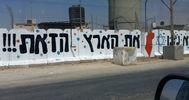
The UN Office for the Coordination of Humanitarian Affairs (OCHA) has reported that Jewish settlers’ violence and vandalism have been on the rise since the beginning of 2018, with a weekly average of five attacks resulting in injuries or property damage, compared with an average of three in 2017 and two in 2016.
According to a report covering Israeli violations from 20 November to 3 December, OCHA said that at least 11 attacks were carried out by settlers and resulted in Palestinian property damage during the reporting period.
Around 85 Palestinian-owned trees were vandalized by Israeli settlers in Turmus’ayya village (Ramallah), while in another five incidents, in al-Mughayyir (Ramallah), Al Jab’a (Bethlehem), Beit Iksa (Jerusalem) and Asira al Qibliya and Huwwara (both in Nablus) villages, settlers punctured the tires of 52 vehicles and sprayed offensive graffiti on some of the vehicles and on the wall of a school, a mosque and several houses.
Settlers and other extrimist Jewish groups also stormed various religious sites in the West Bank, triggering altercations and clashes with Palestinians, which ended in no injuries. The affected sites included the Aqsa Mosque compound in east Jerusalem and a shrine in Sabastiya village.
In another context, the report said that at the pretext of unlicensed construction, the Israeli authorities demolished or seized 33 Palestinian-owned structures in Area C of the West Bank as well as in east Jerusalem, including two structures provided as humanitarian assistance. As a result, 16 people, including six children, were displaced and 226 persons were affected.
While clashes were happening following a search and arrest operation in Tulkarem city on December 4, a 22-year-old Palestinian man with special needs was shot and killed by Israeli forces.
Demonstrations in the context of the ‘Great March of Return’ continued for the 36th successive week, resulting in the injury of 272 Palestinians by Israeli forces, with no fatalities reported. Among the total number of injuries, 79 occurred during marches to protest restrictions on fishing areas in the northern Beit Lahia area, according to the report.
However, Israeli sources indicated that no incendiary kites or balloons were launched and that no attempts were made to breach the fence during any of the demonstrations.
On at least 31 occasions outside of the above-mentioned demonstrations, Israeli forces opened fire in access restricted areas at land and sea in Gaza, injuring one child who approached the perimeter fence. Three fishermen were detained and the livelihoods of Palestinian farmers and fishermen were disrupted. On two occasions, Israeli forces carried out leveling and excavation activities along the perimeter fence inside Gaza.
On November 26, a 32-year-old Palestinian man was shot and killed by Israeli forces, after he reportedly drove his vehicle into a group of soldiers stationed on the main road near Beit Ummar village in al-Khalil, injuring three of them. His body has been withheld by the Israeli authorities since then.
According to Palestinian eyewitnesses, OCHA said, the incident appeared to be a car accident, but Israeli media sources claimed that it was a deliberate attack. Since the beginning of 2018, 30 Palestinians have been killed during attacks or alleged attacks against Israelis in the West Bank.
According to a report covering Israeli violations from 20 November to 3 December, OCHA said that at least 11 attacks were carried out by settlers and resulted in Palestinian property damage during the reporting period.
Around 85 Palestinian-owned trees were vandalized by Israeli settlers in Turmus’ayya village (Ramallah), while in another five incidents, in al-Mughayyir (Ramallah), Al Jab’a (Bethlehem), Beit Iksa (Jerusalem) and Asira al Qibliya and Huwwara (both in Nablus) villages, settlers punctured the tires of 52 vehicles and sprayed offensive graffiti on some of the vehicles and on the wall of a school, a mosque and several houses.
Settlers and other extrimist Jewish groups also stormed various religious sites in the West Bank, triggering altercations and clashes with Palestinians, which ended in no injuries. The affected sites included the Aqsa Mosque compound in east Jerusalem and a shrine in Sabastiya village.
In another context, the report said that at the pretext of unlicensed construction, the Israeli authorities demolished or seized 33 Palestinian-owned structures in Area C of the West Bank as well as in east Jerusalem, including two structures provided as humanitarian assistance. As a result, 16 people, including six children, were displaced and 226 persons were affected.
While clashes were happening following a search and arrest operation in Tulkarem city on December 4, a 22-year-old Palestinian man with special needs was shot and killed by Israeli forces.
Demonstrations in the context of the ‘Great March of Return’ continued for the 36th successive week, resulting in the injury of 272 Palestinians by Israeli forces, with no fatalities reported. Among the total number of injuries, 79 occurred during marches to protest restrictions on fishing areas in the northern Beit Lahia area, according to the report.
However, Israeli sources indicated that no incendiary kites or balloons were launched and that no attempts were made to breach the fence during any of the demonstrations.
On at least 31 occasions outside of the above-mentioned demonstrations, Israeli forces opened fire in access restricted areas at land and sea in Gaza, injuring one child who approached the perimeter fence. Three fishermen were detained and the livelihoods of Palestinian farmers and fishermen were disrupted. On two occasions, Israeli forces carried out leveling and excavation activities along the perimeter fence inside Gaza.
On November 26, a 32-year-old Palestinian man was shot and killed by Israeli forces, after he reportedly drove his vehicle into a group of soldiers stationed on the main road near Beit Ummar village in al-Khalil, injuring three of them. His body has been withheld by the Israeli authorities since then.
According to Palestinian eyewitnesses, OCHA said, the incident appeared to be a car accident, but Israeli media sources claimed that it was a deliberate attack. Since the beginning of 2018, 30 Palestinians have been killed during attacks or alleged attacks against Israelis in the West Bank.
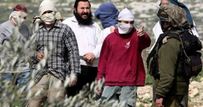
A group of Israeli settlers on Saturday morning attacked a Palestinian family in the Old City of al-Khalil, south of the West Bank.
The PIC reporter said that a child identified as Ruba al-Natsha was transferred to a local hospital after she suffered bruises and wounds in her legs.
Israeli settlers living in Beit Romano outpost in the Old City early on Saturday attacked a neighboring Palestinian house belonging to al-Natsha family and assaulted its residents.
Um Hani al-Natsha, 56, told the PIC reporter that the settlers attack them on almost a daily basis in an attempt to force them out of their home. "We are not leaving even if they kill us," she stressed.
The PIC reporter said that a child identified as Ruba al-Natsha was transferred to a local hospital after she suffered bruises and wounds in her legs.
Israeli settlers living in Beit Romano outpost in the Old City early on Saturday attacked a neighboring Palestinian house belonging to al-Natsha family and assaulted its residents.
Um Hani al-Natsha, 56, told the PIC reporter that the settlers attack them on almost a daily basis in an attempt to force them out of their home. "We are not leaving even if they kill us," she stressed.
6 dec 2018
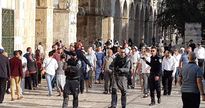
Scores of Israeli settlers forced their way into Jerusalem’s holy al-Aqsa Mosque on Thursday morning, marking the Jewish Hanukkah holiday.
135 Jewish settlers stormed the holy site through the al-Maghareba Gate, as they were escorted by dozens of Israeli policemen during the break-in.
The settlers toured the compound and performed Talmudic rituals.
Dozens of other settlers are expected to show up at the site in the afternoon break-in shift.
Israeli fanatic groups have called on settlers to join mass break-ins at the mosque this week to celebrate the Jewish Hanukkah holidays.
135 Jewish settlers stormed the holy site through the al-Maghareba Gate, as they were escorted by dozens of Israeli policemen during the break-in.
The settlers toured the compound and performed Talmudic rituals.
Dozens of other settlers are expected to show up at the site in the afternoon break-in shift.
Israeli fanatic groups have called on settlers to join mass break-ins at the mosque this week to celebrate the Jewish Hanukkah holidays.

The Jordanian ministry of religious affairs has affirmed that the Aqsa Mosque belongs to the Muslim nation alone and “cannot be divided or shared.”
This came in remarks made by minister Abdul-Naser Abul-Basel during a news conference held to make an announcement about the international conference on Jerusalem and the Aqsa Mosque to be held on December 20 under the auspices of Jordanian King Abdullah II.
Abul-Basel stated that there would be active and wide participation in the conference by noted figures from all spectra and different countries, including religious scholars, politicians, academics and activists.
He said that the increasing frequency of Jewish break-ins and violations at the Aqsa Mosque was the main reason for deciding to hold the conference.
This came in remarks made by minister Abdul-Naser Abul-Basel during a news conference held to make an announcement about the international conference on Jerusalem and the Aqsa Mosque to be held on December 20 under the auspices of Jordanian King Abdullah II.
Abul-Basel stated that there would be active and wide participation in the conference by noted figures from all spectra and different countries, including religious scholars, politicians, academics and activists.
He said that the increasing frequency of Jewish break-ins and violations at the Aqsa Mosque was the main reason for deciding to hold the conference.
5 dec 2018
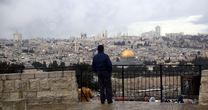
Israel's Magistrate Court of Jerusalem on Wednesday ordered the eviction of a Palestinian family from their property in Silwan town, south of Occupied Jerusalem.
Wadi Hilweh Information Center reported in a statement that the court decision gives the family (the heirs of the late Mariam Abu Zuweir) a time limit until March 2019 to evacuate the house.
The targeted property is a house where a Palestinian woman, Ilham Syam, and four of her children live, in addition to a 500-square-meter land.
Wadi Hilweh Center said that the Magistrate Court issued the eviction order before a session appointed by the Supreme Court on 8 January to decide the ownership of the land. Documents were submitted to the court stating that the land on which the house is built belongs to the late Jamil Syam and not to the late Abu Zuweir.
Abu Zuweir's heirs have been engaged in a conflict at Israeli courts for 22 years to prove their ownership of the property and to refute the claims of the Elad Settlement Association.
Nehad Syam, one of the heirs, explained that over the past years, Elad has worked hard to seize the property in a number of ways.
Syam said that after several court sessions, it was found out that Elad had bought 4 shares from the heirs in addition to two shares under "absentee property," leaving only two shares for the late Munira Abu Zuwier and her sister Fatima. A decision to evict the family in favor of the settlers was issued on Wednesday, he added.
He pointed out that the family will object to the eviction order at Israel's Jerusalem District Court.
According to the United Nations Office for the Coordination of Humanitarian Affairs (OCHA), at least 180 Palestinian families are facing the risk of forced eviction from their homes in Jerusalem due to cases brought against them by settlers or settler associations.
Wadi Hilweh Information Center reported in a statement that the court decision gives the family (the heirs of the late Mariam Abu Zuweir) a time limit until March 2019 to evacuate the house.
The targeted property is a house where a Palestinian woman, Ilham Syam, and four of her children live, in addition to a 500-square-meter land.
Wadi Hilweh Center said that the Magistrate Court issued the eviction order before a session appointed by the Supreme Court on 8 January to decide the ownership of the land. Documents were submitted to the court stating that the land on which the house is built belongs to the late Jamil Syam and not to the late Abu Zuweir.
Abu Zuweir's heirs have been engaged in a conflict at Israeli courts for 22 years to prove their ownership of the property and to refute the claims of the Elad Settlement Association.
Nehad Syam, one of the heirs, explained that over the past years, Elad has worked hard to seize the property in a number of ways.
Syam said that after several court sessions, it was found out that Elad had bought 4 shares from the heirs in addition to two shares under "absentee property," leaving only two shares for the late Munira Abu Zuwier and her sister Fatima. A decision to evict the family in favor of the settlers was issued on Wednesday, he added.
He pointed out that the family will object to the eviction order at Israel's Jerusalem District Court.
According to the United Nations Office for the Coordination of Humanitarian Affairs (OCHA), at least 180 Palestinian families are facing the risk of forced eviction from their homes in Jerusalem due to cases brought against them by settlers or settler associations.
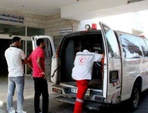
Palestinian medical sources have reported, Wednesday, that an elderly woman was injured, south of the West Bank city of Bethlehem, after a speeding illegal Israeli colonialist setter rammed her with his car.
Mohammad Awad, the head of the Emergency Department of the Palestinian Red Crescent Society (PRCS) in Bethlehem, said the woman has been identified as Fatima Issa, 70, from Jouret ash-Sham’a village, south of Bethlehem.
She was rammed by a speeding colonialist settler near the junction of Efrat illegal colony, built on Palestinian lands, south of Bethlehem.
Awad added that the wounded elderly woman was rushed to al-Yamamah General Hospital, in Bethlehem, after suffering a dislocated shoulder, in addition to various cuts and bruises.
Mohammad Awad, the head of the Emergency Department of the Palestinian Red Crescent Society (PRCS) in Bethlehem, said the woman has been identified as Fatima Issa, 70, from Jouret ash-Sham’a village, south of Bethlehem.
She was rammed by a speeding colonialist settler near the junction of Efrat illegal colony, built on Palestinian lands, south of Bethlehem.
Awad added that the wounded elderly woman was rushed to al-Yamamah General Hospital, in Bethlehem, after suffering a dislocated shoulder, in addition to various cuts and bruises.
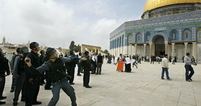
Scores of Israeli settlers forced their way into al-Aqsa Mosque compound on Wednesday morning marking the Jewish Hanukkah holidays.
Around 152 Jewish settlers stormed the holy compound through the Al-Magharbeh Gate joined by dozens of Israeli policemen during the tour, Quds Press reported.
The settlers wandered around the compound and attempted to perform Talmudic rituals.
Jewish organizations had earlier called on supporters to storm the mosque compound this week to mark the advent of the Jewish Hanukkah holidays.
Around 152 Jewish settlers stormed the holy compound through the Al-Magharbeh Gate joined by dozens of Israeli policemen during the tour, Quds Press reported.
The settlers wandered around the compound and attempted to perform Talmudic rituals.
Jewish organizations had earlier called on supporters to storm the mosque compound this week to mark the advent of the Jewish Hanukkah holidays.
4 dec 2018
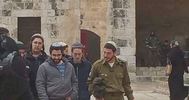
Dozens of Jewish settlers on Tuesday morning forced their way into al-Aqsa Mosque through al-Maghareba Gate under the protection of the Israeli police.
Quds Press reported that 56 Israeli settlers stormed al-Aqsa Mosque and were given presentations on the alleged "Temple Mount" as they roamed the Mosque's courtyards on the second day of Hanukkah festival.
The news agency said that large police forces accompanied the settlers during the tour until they left the site via al-Silsila Gate.
It added that the morning break-in lasted for three hours and a half, while more settlers are expected to visit the Mosque for a one-hour tour following noon prayer.
In a related context, dozens of Israeli settlers on Monday evening gathered at al-Aqsa gates, performed Talmudic rituals and provocative dances, threw wine-drinking parties, and lit the Hanukkah candles.
Quds Press reported that 56 Israeli settlers stormed al-Aqsa Mosque and were given presentations on the alleged "Temple Mount" as they roamed the Mosque's courtyards on the second day of Hanukkah festival.
The news agency said that large police forces accompanied the settlers during the tour until they left the site via al-Silsila Gate.
It added that the morning break-in lasted for three hours and a half, while more settlers are expected to visit the Mosque for a one-hour tour following noon prayer.
In a related context, dozens of Israeli settlers on Monday evening gathered at al-Aqsa gates, performed Talmudic rituals and provocative dances, threw wine-drinking parties, and lit the Hanukkah candles.
